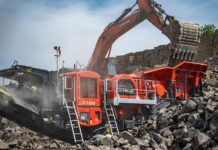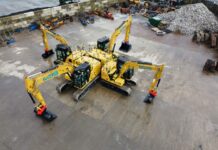One breaker steel looks much like another, so it can be difficult to make sensible judgements about quality. Linlithgow-based Rock Force shared some of its expertise with Project Plant

FAILURE of a breaker steel can arise for many reasons. One of the most common failure mechanisms comes from using the breaker at the wrong angle. “They should always be used at 90º to the ground,” says Mafdy Atalia of Linlithgow based Rock Force, a company that supplies both breaker steels – or chisels – and ground engagement tools.
But it certainly helps if the steel offers an appropriate form of resistance to this kind of leverage. Atalia highlights one of the hallmarks of a quality steel as the extent to which it offers hardness with flexibility. “The principle is the same as with the trunk of a tree,” he explains, adding that a tree can sway in the wind without breaking. It can do this because there is a natural variation in hardness between the centre of the tree and its outside surface. Similarly a breaker steel should be engineered to provide this gradient of hardness between the centre and the outside edge – say, 44 R at the centre and 52 R at the outside, to give a typical example.

How this is achieved is to do with the way the steel is treated: A specialised form of heat treatment that causes the carbon atoms within the material to reorganise.
Much is made of the quality shortcuts apparent in products from some Far Eastern producers, and this is one of the common omissions apparent in the way many products have been manufactured, he seems to suggest.
An additional factor that makes for a robust steel – one that can survive this kind of leverage, in other words – is ensuring that the bushing is harder than the chisel – for example, 62 R if the chisel is rated at 52 R. This is just one of the priorities that feature in Atalia’s manufacturing plans, with the company currently working towards the objective of manufacturing many of its own steels and consumables within the next three years. At present Rock Force uses steels manufactured in England, and consumables manufactured on the European mainland.

Rock Force caters for the high quality end of the market in addition to products which Atalia says “are not as cheap as China but provide value for money”.
Quite apart from product failures, there also the issue of simple wear. Friction between the bushing and the chisel is what leads to wear, but it can be reduced by the application of grease. “One of the main problems in this industry,” he says, “aside from the use of cheap tools, is that the operator will forget to lubricate the hammer.” Grease should be applied regularly. It also needs to be the right grease, says Atalia, with a high melting point – “normal grease evaporates like water” – and dosed with the right additives, such as copper particles.
The company caters for the full range of steel sizes, from the smaller 30 mm parts for pavement drilling and water pipe repair up to the larger 220 mm diameter steels, used in areas like demolition and secondary breaking in quarries.
The other principal failure mechanism he mentions is to do with the time during which the breaker is kept in contact with the ground. It should only do so for a few seconds at a time, but people naturally want to simply get on with the job. “There are simple rules – if you follow them you shouldn’t need to replace any parts in the short term.”

The cutting edge
The other major area of activity for Rock Force is in ground engagement tools, something that accounts for around 60% of its business. At present it acts as a UK distributor for Canadian manufacturer Black Cat Blades, a maker of consumables for ground engagement tools, positioned at the high quality end of the market.
With the media warning of a severe winter in the pipeline, it’s possibly good timing that one of the latest products Rock Force is introducing in the UK is BCB’s Joma 6000 blades for snow ploughs. Something of a grail in the snow plough arena, understandably enough, is a blade that can scrape road ice effectively and also last for a long time. The Joma 6000 apparently makes important inroads here through its use of floating segment bushings, which provide some movement and give between the blade segment (impregnated with a tungsten carbide blade) and the rest of the housing (see image, below).
Rock Force tested some of these in 2010, says Atalia, in places like Aberdeenshire and Argyll & Bute. “We tend to rely on salt in the UK [ for de-icing ]. But once you get below -10ºC, salt doesn’t work. You get what happened on the M8 in 2010,” he says.









